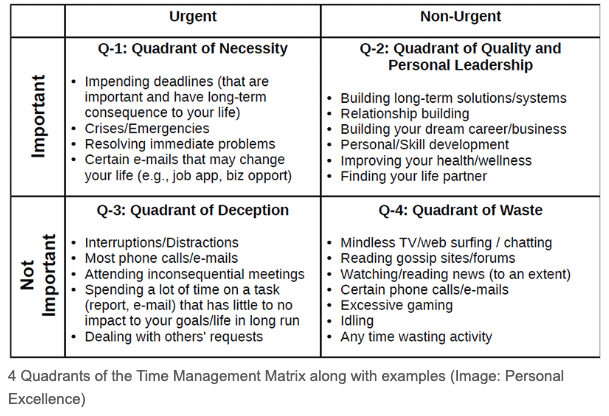In today’s fast-paced world, the ability to manage our time effectively has become more crucial than ever. With numerous tasks, responsibilities, and distractions demanding our attention, it’s easy to lose sight of what truly matters and get caught up in a cycle of busyness without productivity. However, by implementing the principle of “Put First Things First” from Stephen R. Covey’s book, “The 7 Habits of Highly Effective People,” we can transform our approach to time management and achieve meaningful results.

Understanding the Habit
“Put First Things First” is the third habit in Covey’s book and emphasizes the importance of prioritizing activities based on their significance rather than urgency. It involves aligning our actions with our values and long-term goals to ensure that we focus on activities that contribute to our personal and professional growth.
The Time Management Matrix
To effectively put first things first, Covey introduces the Time Management Matrix, which categorizes tasks into four quadrants: Urgent and Important, Not Urgent but Important, Urgent but Not Important, and Not Urgent and Not Important. By evaluating our tasks and placing them in the appropriate quadrant, we can prioritize our time and energy on activities that have the greatest impact.
The Power of Quadrant II
Quadrant II, representing activities that are Important but Not Urgent, holds the key to true effectiveness. These activities include strategic planning, goal setting, self-care, building relationships, and personal development. By dedicating more time to Quadrant II tasks, we can proactively prevent crises, reduce stress, and make significant progress toward our long-term objectives.
Overcoming Obstacles and Challenges
Putting first things first is not without its challenges. We often face distractions, procrastination, and the fear of missing out (FOMO), which can derail our efforts. This section explores practical strategies to overcome these obstacles, such as setting clear goals, creating a daily schedule, using productivity tools, practicing self-discipline, and learning to say “no” to non-essential tasks.
Developing Effective Time Management Skills
To fully embrace the habit of putting first things first, we must develop essential time management skills. This section covers techniques like prioritization, delegation, batching similar tasks, setting deadlines, avoiding multitasking, and optimizing our environment for productivity. Additionally, we explore the importance of maintaining a healthy work-life balance and incorporating regular breaks and rest into our routines.
Applying “Put First Things First” in Different Areas of Life
The principle of putting first things first extends beyond the professional realm. In this section, we discuss how we can apply this habit in various aspects of our lives, including personal relationships, health and fitness, finances, and lifelong learning. By consciously allocating our time and energy to activities that align with our values and priorities, we can lead a more fulfilling and balanced life.
Conclusion
“Put First Things First” is a powerful concept that can revolutionize the way we manage our time and achieve our goals. By adopting the principles and strategies outlined in Covey’s book, we can break free from the cycle of busyness and focus on activities that truly matter. Implementing this habit requires self-awareness, discipline, and a commitment to personal growth, but the rewards are immense. As we consistently prioritize our time, align our actions with our values, and invest in activities that bring us closer to our aspirations, we unlock our true potential and become highly effective individuals capable of making a lasting impact.


